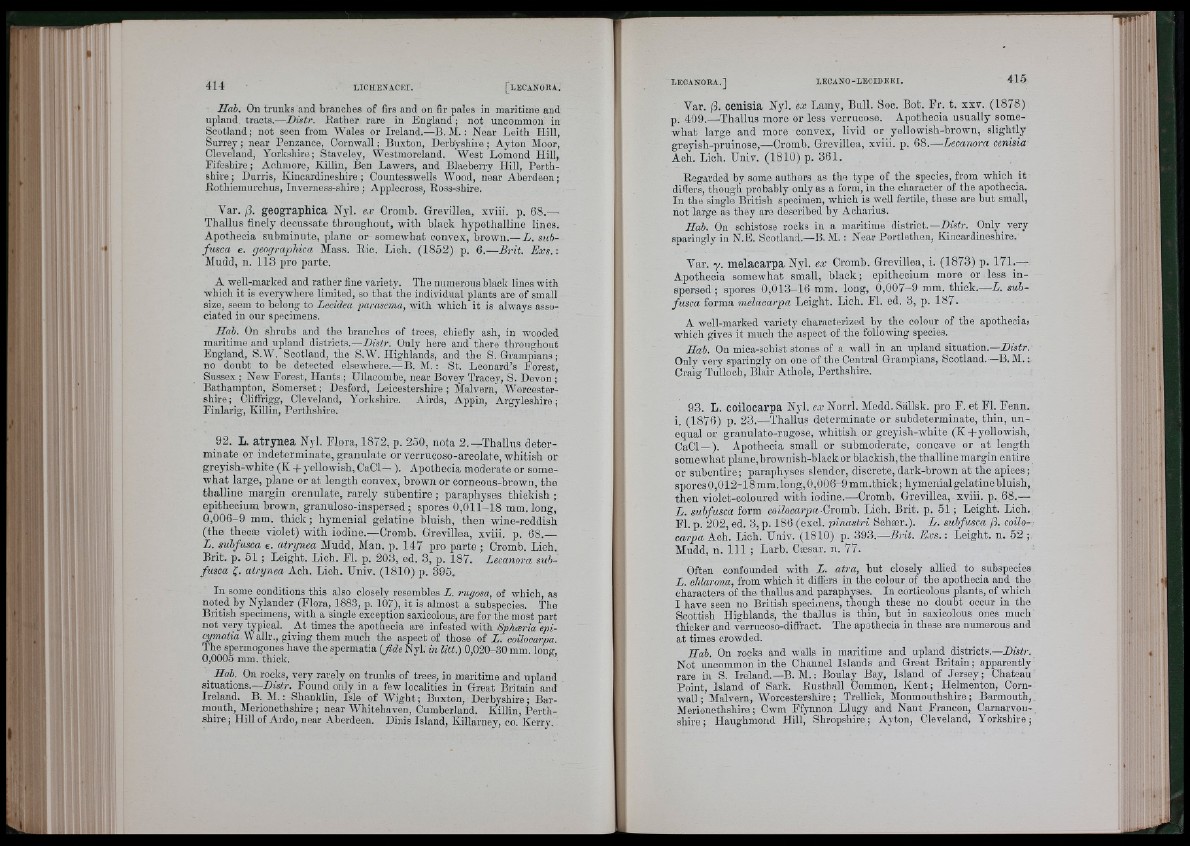
Hah. On trunks and branches of firs and on fir palea in maritime and
upland tracts.—Distr. Kather rare in England ; not uncommon in
Scotland; not seen from Wales or Ireland.—B. M. : Near Leith Hill,
Surrey; near Penzance, Oornwall; Buxton, Derbyshire; Ayton Moor,
Cleveland, Yorksliire; Staveley, Westmoreland. West Lomond Hill,
Fifeshire ; Achmore, Killin, Beu Lawers, and Blaeberry Hill, Perth-
shire; Durris, Kincardineshire; Countesswells Wood, near Aberdeen ;
Kotblemurcbus, Inverness-sbire ; Applecross, Ross-shire.
Var. fl. geographica Nyl. ex Cromb. Grevillea, xviii. p. 08.—
Tliallus finely decussate tlirougliout, with black hypothalline lines.
Apotheoia subminnte, plane or somewhat convex, brown.—X. suA-
fu sca e. cjengraphica Mass. Bic. Lich. (1852) p. 6.—B rit. Exs. :
Mudd, n. 113 pro parto.
A well-marked and rather fine variety. The numerous black lines with
whicli it is everywhere limited, so th at'th e individual plants are of small
size, seem to belong to Lecidea parasema, with which it is always associated
iu our specimens.
Hab. On shrubs and the branches of trees chiefly ash, iu wooded
maritime and upland districts.—Distr. Only here and there throughout
Fngland, S.W. Scotlaud, the S.M’. Highlands, and the S. Grampians ;
no doubt to be detected elsewhere.—B. M. : St. Leonard’s I ’orest,
Sussex ; New Fore.st, Hants ; Ullacombe, near Bovey Tracey, S. Devon ;
Bathampton, Somerset ; Desford, Leicestershire ; Malvern] Worcestershire;
Cliffrigg, Cleveland, A’orkshire. Airds, Appin, Argyleshire;
Finlarig, Killin, Perthshire.
92. L. atrynea Nyl. Flora, 1872, p. 250, nota 2 .—Thallus d e te rminate
or in d eterm inate, granulate or verrueoso-areolate, whitish or
greyish-white (K + yellowish, CaCl— ). Apothecia moderate or somew
h a t large, plane or a t length convex, brown or oorneous-browo, th e
thalline margin crenulate, rarely subentire ; paraphyses thickish ;
epitheoium brown, granuloso-insperaed ; spores 0,011-18 mm. long,
0,006-9 mm. thiok ; hymenial gelatine bluish, then wine-reddish
(th e theoæ violet) with iodine.—Cromb. Grevillea, xviii. p. 68.—
X. subfusca e. atrynea Mudd, Man. p. 147 pro parte ; Cromb. Lioh.
Brit. p. 61 ; Leight. Lich. Fl. p. 203, ed. 3, p. 187. Lecanora subfusca
if. atrynea Aoh. Lioh. Univ. (1810) p. 395.
In some conditions this also closely resembles X. rugosa, of which, as
noted by Nylander (Flora, 1883, p. 107), it is almost a subspecies. The
British specimens, with a single exception saxicolous, are for the most part
not very typical. At times the apothecia are infested with Sphæria epi-
cymoiia Wallr., giving them much the aspect of those of X. coilocaipa.
The spermogones have the spermatia (fide Nyl. in litt.) 0,020-80 mm. lone-,
0,0005 mm. thick. J / , (<,
_ H a k On rocks, very rarely on trunks of trees, in maritime and upland
situations.—Distr. Found only in a few localities in Great Britain and
Ireland. B. M. : Shanklin, Isle of W ig h t; Buxton, Derbyshire; Barmouth,
Merionethshire ; near Whitehaven, Cumberland. Killin, Perthshire
; Hill of Ardo, near Aberdeen. Dinis Island, Killarney, co. Kerry.
Var. fl. cenisia Nyl. ex Lamy, Bull. Soo. Bot. F r. t. xxv. (1878)
p. 409.—^Thallus more or less verrucose. Apotheoia usually somewh
a t large and more convex, livid or yellowish-brown, slightly
greyish-pruinose,—Cromb. Grevillea, xviii. p. 68.— Lecanora cenisia
Aoh. Lioh. Univ. (1 8 1 0 ) p. 361.
Regarded by some authors as the type of the species, from which it
differs, thougli probably only as a form, in the character of the apothecia.
In the single British specimen, whioh is well fertile, these are but small,
not large as they are described by Acharius.
Hab. On schistose rocks in a maritime district.—Df.sfr. Only very
sparingly in N.E. Scotland.—B. AI. : Near Portlethen, Kincardineshire.
Var. y. melacarpa Nyl. ex Cromb. Grevillea, i. (1873) p. 171.—•
Apothecia somowhat small, b la ck ; epithecium more or loss in spersed
; spores 0 ,0 1 3 -1 6 mm. long, 0,007—9 mm. thick.—X. subfusca
forma melacarpa Loight. Lich. Fl. ed. 3, p. 187.
A well-marked variety characterized by the colour of the apotheciai
which gives it much tho aspect of the following species.
Hab. Ou mica-schist stones of a wall in an uifiand situation.—D/sfr.
Only very sparingly on one of the Central Grampians, Scotland.—B. M. ;
Craig Tulloch, Blair Athole, Perthshire.
93. L. co ilo c a rp a Nyl. ex Norrl. Medd. Sallsk. pro F . et Fl. Fenn.
i. ( 1876) p. 23.—Thallus determinate or subdeterminate, th in , u n equal
or granulato-rugose, whitish or greyish-white (K + y ellow ish ,
QaCl —). Apothecia small or submoderate, concave or a t length
somewhat plane, brownish-blaok or blackish, th e thalline m argin entire
or subcntire; paraphyses slender, discrete, dark-brown a t the apices;
spores 0,012-18 mm. long, 0,006-9 mm. thick; hymenial gelatine bluish,
th en violet-coloured with iodine.—Cromb. Grevillea, xviii. p. 68.—
X. subfusca form coilocarpa Cromb. Lioh. Brit. p. 5 1 ; Loight. Lioh.
F l. p. 202, ed. 3, p. 186 (excl. pinastri Schær.). X. subfusca fl. coilocarpa
Ach. Lioh. Univ. (1810) p. 3 93.—B rit. E.vs. : Leight. n. 52 ;
Mudd, n. I l l ; Larb. Cæsar. n. 77.
Often confounded with X. atra, but closely allied to subspecies
X. chlarona, from which it differs in the colour of tbe apothecia and the
characters of the thallus and paraphyses. In corticolous plants, of which
I have seen no British specimens, though these no doubt occur in the
Scottish Highlands, the thallus is thin, but in saxicolous ones much
thicker and verrucoso-diffract. The apothecia in these are numerous aud
at times crowded.
Hab. On rocks and walls iu maritime and upland distriets.—Distr.
Not uncommon in the Channel Islands and Great Britain ; apparently
rare in S. Ireland.—B.AI.: Boulay Bay, Island of Jersey; Chateau
Point, Island of Sark. Rusthall Common, Ken t; Helmenton, Cornwall
; Alalvern, AVorcestershire ; Trellick, Alonmouthsbire ; Barmouth,
Merionethshire; Cwm Ffynnon Llugy and Naut Francon, Carnarvoii-
•shire; Hauglimond Hill, Shropshire; Ayton, Cleveland, A’orkshire;